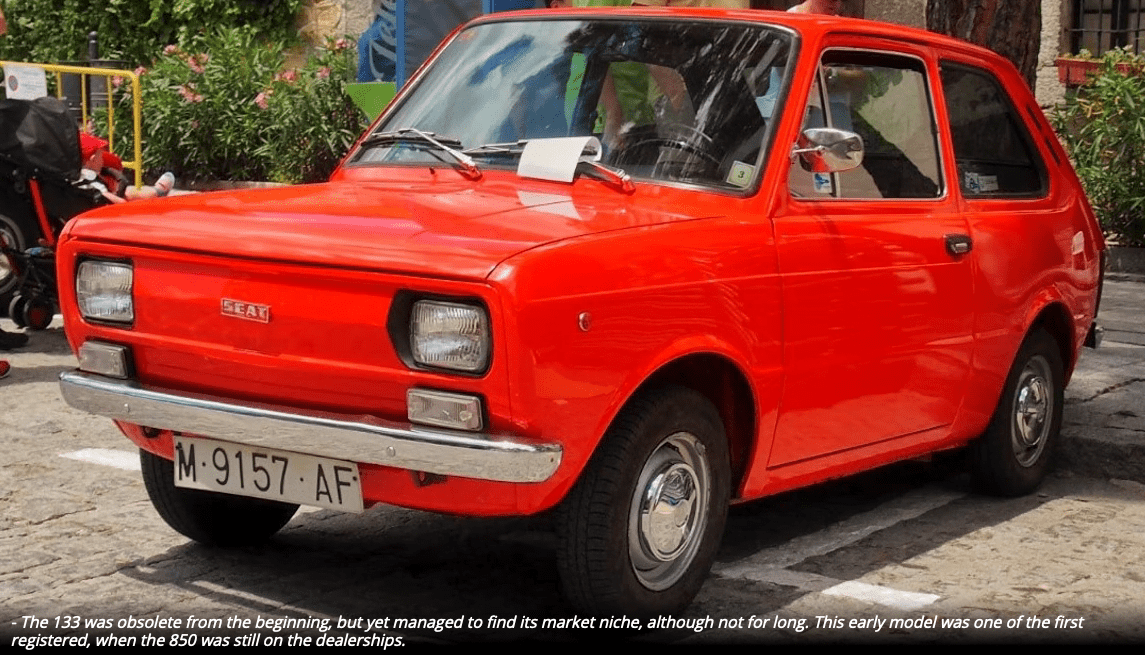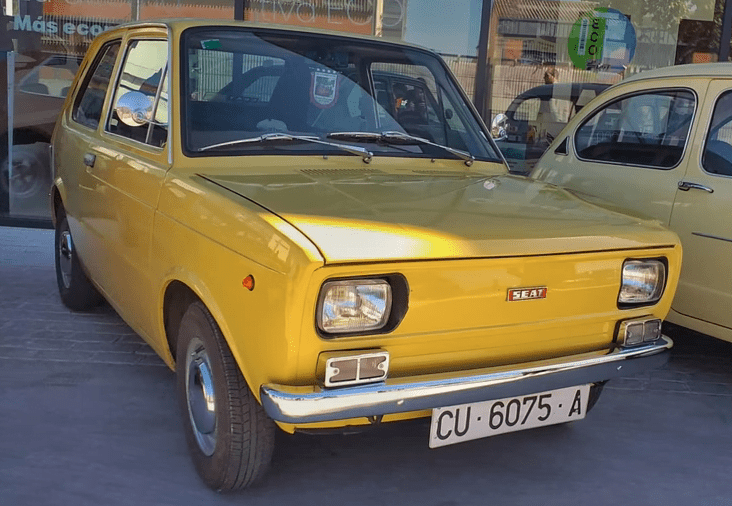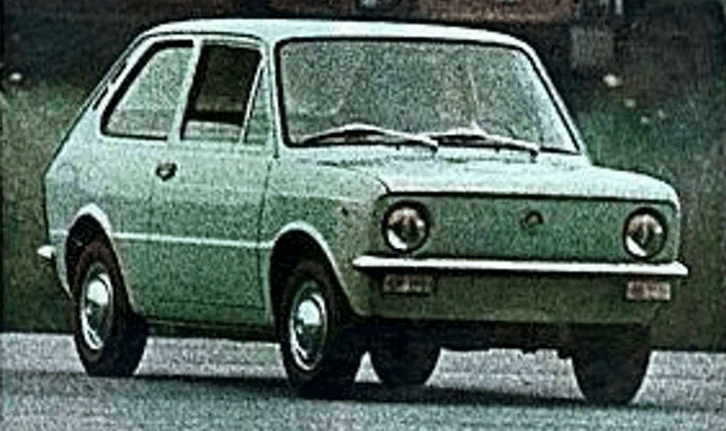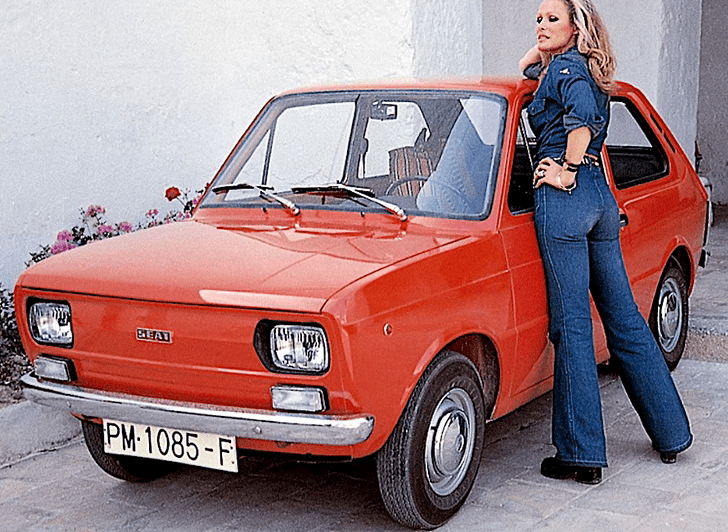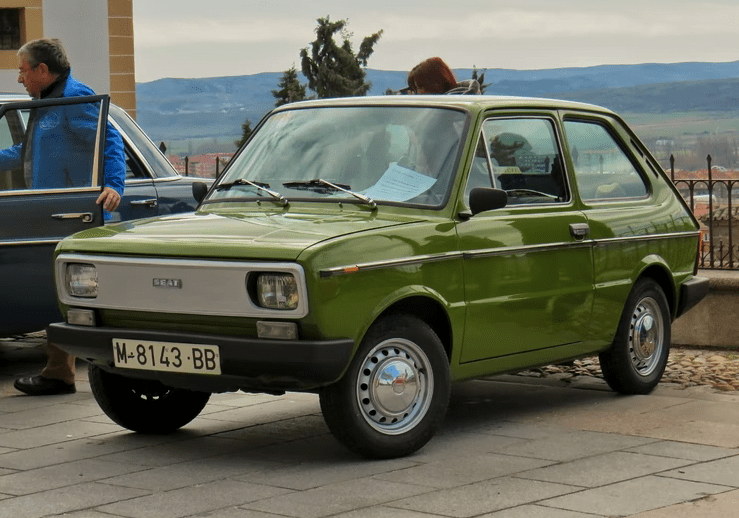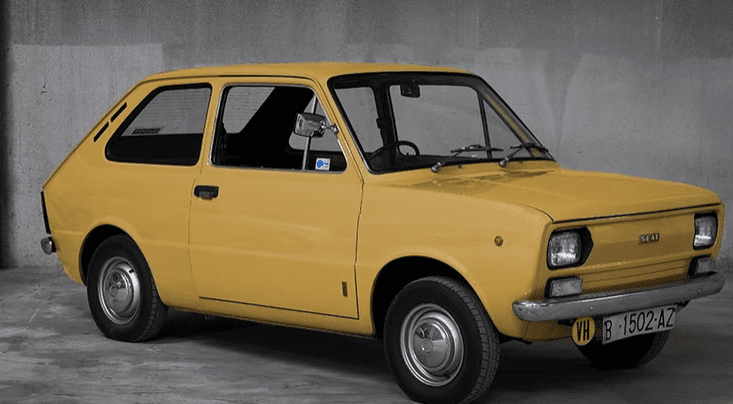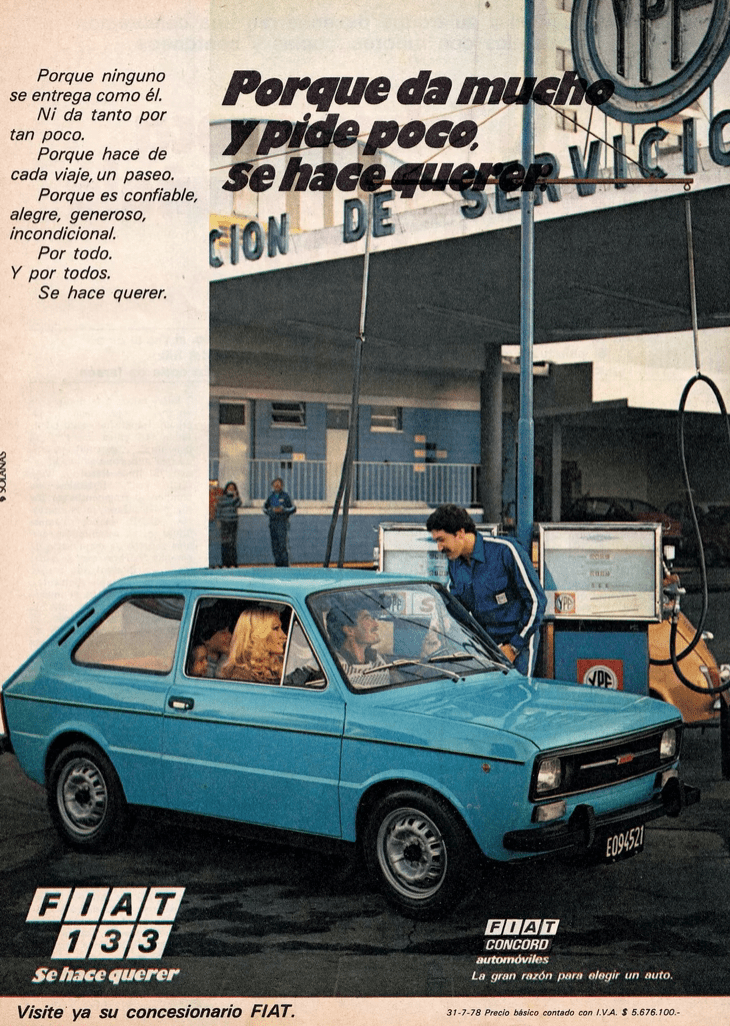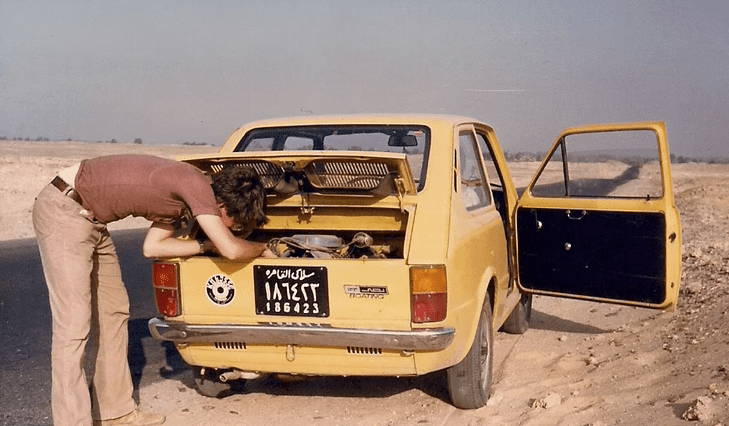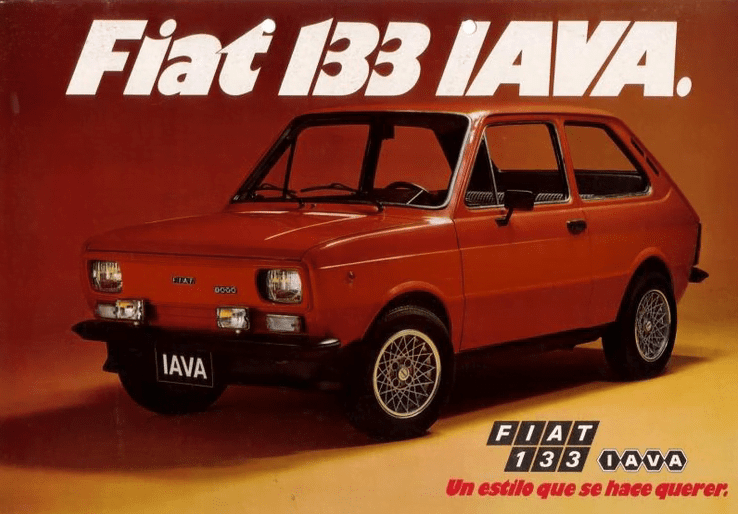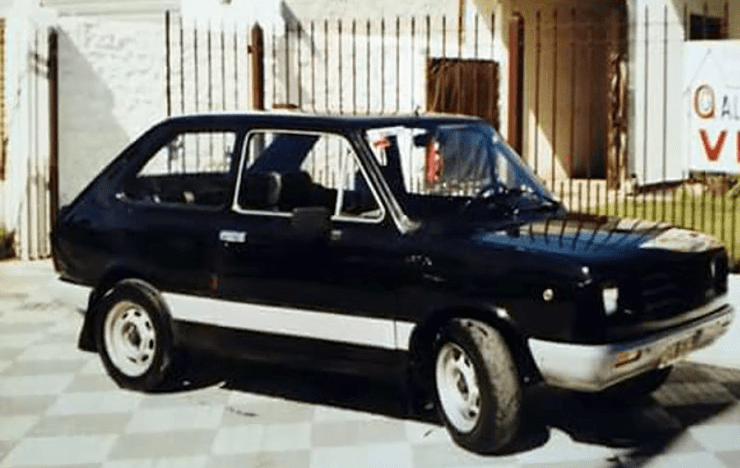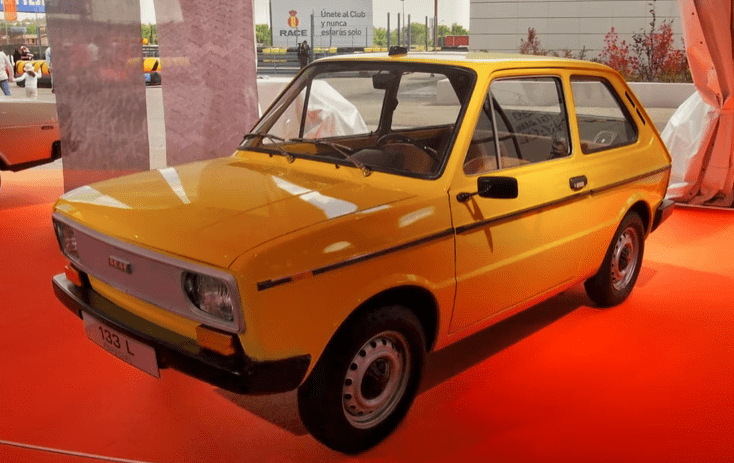Born from a discarded FIAT project, the 133 was the first SEAT to be built outside Spain, in places as exotic as Argentina or Egypt.
By the late 60’s, the whole European automotive industry had a clear idea of what was going to be the car for the seventies. A compact, front wheel drive vehicle, with a rear hatch and squared lines body. Well, when i say the whole industry, i mean most of it because there were still some doubts on the biggest European manufacturer: FIAT.
For many years, the Turinese brand rejected to build FWD vehicles, at least, under their own brand. The arrival of the Innocenti cars in the early 60’s to the Italian market, especially the Mini, forced FIAT to make a move.
In 1964, FIAT launched its first front wheel drive car. Putting to a good use the Autobianchi brand, the company developed an ultra modern compact two box body sedan released to the market as Autobianchi Primula. The car was a moderate sales success, with around 70000 sold until 1970. The Primula was the first test for futures FWD FIAT vehicles. In 1969 Autobianchi launched the A111, a sedan derived from the discarded front wheel drive car developed in parallel with the 124 and the A112, a tiny hatchback oriented to an upmarket niche. Both cars had a mixed success: The A111 was a fail, while the A112 became an icon.
In 1966, Gianni Agnelli was appointed as CEO of FIAT. Agnelli was not only the man who recovered the company for its family; he was also the person who was decided to modernize it. He believed that FIAT needed to embrace the FWD trend in order to keep the brand as the reference car maker on the small car segment, so, greenlighted the car that would revolutionize the small car market in Europe: The 127.
However, there was still some resistance on the directors board to such innovative kind of vehicle. So, at the same time, another supermini, based on the 850 was developed as well, keeping the 843cc engine, the 850 chassis and RR layout. In late 1971, the FIAT 127 was unveiled, while the RR layout model developed in parallel was kept in a drawer. But not for long.
The 133 project finds a way: Made in Spain.
Despite being developed as a classic alternative to the groundbreaking 127, the 133 was positioned below it, as an entry level model.
The early seventies was a time of change at SEAT. In 1969, the millionth car was built, and by then, exports to Europe and other foreign markets were on the rise. The introduction in the spring of 1972 of the SEAT 127, began the modernization of a range that was beginning to feel a bit old fashioned.
During the following two years, all the models introduced in the 60’s were phased out: the 1500 in late 1972, the 600 in August 1973 and the 850 in August 1974. However, the discontinuation of the small rear engined cars, would leave SEAT with the lowest part of the range uncovered, as it wouldn’t have a product to fight against the cheapest models from FASA Renault, AUTHI and Citroen Hispania.
By early 1972, it was clear that the 600 needed to be replaced in a very short time and that the 850 would not last much longer. SEAT began to look for a replacement for both models in the FIAT catalogue, with no avail. The only model smaller than the 127 was the upcoming FIAT 126, a tiny car developed to replace the Nuova 500 and deemed as too small and too underpowered by SEAT.
In early 1973 the first prototypes of the future 600 and 850 replacement were spotted at the Zona Franca factory.
Nevertheless, SEAT found a solution on the FIAT abandoned projects drawer. The discarded project developed in parallel to the 127 seemed the perfect solution. The new vehicle, that would be known first as “SEAT 100 R” and later as “Progetto 133” was going to be designed to use the chassis, engines and other mechanical bits of the SEAT 850, what meant big savings on development costs. Also, the new model would be able to use the same assembly line including welding machinery. By early 1973 the first prototypes were built, and despite it would gain some external changes, like a front fascia more similar to the 127, the car was almost ready.
The car was going to be important for SEAT, as it was going to have an entry level model to attract the most budget restrained customers. But also for FIAT, which would be able to amortize the development costs of a model that was almost mature for launch. And that was because FIAT had the idea of exporting the 133 as an entry level cars to those markets where the 126 was regarded as too small.
In theory, it was all advantages from a cost efficiency point of view. From the market point of view, things were not so clear, as rear engined cars were in retreat, with customers less and less interested in that kind of vehicles.
In any case, the new product, that finally was going to be baptised as SEAT 133, became the first car developed by FIAT but built exclusively by SEAT. A situation that would never happen again with any other model.
“A car like this, should be made now”: The SEAT 133 arrives to the market
In the spring of 1974, the SEAT 133 was finally launched. Ursula Andress was chosen to promote the new model.
In May 1974, after less than a year and a half of development, the SEAT 133 was released. SEAT prepared a launch campaigh for its new model with heavy advertising in TV and press under a slogan that said “Había que hacer un coche asi, y había que hacerlo ya” (A car like this had to be made now”). Ursula Andress was also hired to promote the new model. SEAT had high hopes for the new 133.
For the first time in Spain, a car was available in two different engine setups, a low compression one, to be used with 85 NO petrol and a high compression one to be used with 90 NO petrol. Mechanically, the 133 was exactly like a SEAT 850 D: it featured a 843cc engine that developed 34 or 37 hp, depending on the compression rate, four drum brakes on 12 inch wheels and a full synchromesh four speed gearbox.
The body kept the same wheelbase as the two door SEAT 850, but the 133 was slightly shorter overall. The design was a bit of a mixture between a 126 and a 127, with a size halfway between them. The semi fastback look masked quite well the rear engine layout.
Priced at 132000 Pesetas (10400€ in today money), and with no cheaper cars on the SEAT range except the remaining stock of 40000 SEAT 850 still unsold, the 133 received a warm welcome from the buyers. Warm but not hot, as the price difference with a much better
SEAT 127 was barely 30000 Pesetas (Today 2200€) and the 127 was vastly superior product.
The motor press gave the 133 a lukewarm reception. While they considered the car better than its predecessors, they also thought that times had changed and therefore, a rear engined car was not up to the driving standards and performance found on FWD vehicles. In short, the 133 was for most of the critics, a car that arrived five years late.
New engines, new horizons: The 133 becomes international.
Introduced in the summer of 1975, the SEAT 133 Especial solved some of the original model problems.
The 133 range didn’t have any novelties untilt the summer of 1975, a year after its release. In July, SEAT launched the 133 Especial, a well awaited version that should address some of the weaker points of the standard version.
The 133 Especial received a new tuned up version of the 843cc engine, that now developed 44hp. It also received front disc brakes and 13 inch perforated wheels. The rest, remained the same as the basic model. The 133 Especial replaced the standard 37hp version.
At the same time, another model broadened the range: The 133 Lujo. The 133 L had a different aesthetic. as it include plastic trim pieces, painted in metallic silver in both the front and rear ends, polyurethane black bumpers, and tinted glass. Inside, the Lujo model received reclining seats, better upholstery, rear screen defrosting and other small equipment details
The SEAT 133 Lujo and Especial Lujo received a more sought after equipment and more modern aesthetics.
The 133 Lujo was available with both engines, so the from the summer of 1975 the range was composed of four models: 133 (34hp), 133 Lujo (34 hp) 133 Especial (44 hp) and 133 Especial Lujo (44 hp). SEAT was definitely giving the customers a good amount of choices.
The SEAT 133 number 50000 rolled off the assembly line that summer as well, and at the same time, exports to European markets began, including the United Kingdom and Ireland, markets that received for the first time a SEAT in RHD form. Other markets that received the 133 were the Netherlands, Belgium, Germany, Greece or Finland. In all of them, the 133 found a small but profitable market niche.
A RHD SEAT 133 that never was exported and was registered in Barcelona. Apart from the steering wheel and windshield wipers position, the speedometer is measured in miles. This car belongs to the SEAT en Rodaje collection (www.seatenrodaje.es)
With the range fully developed, SEAT didn’t introduce any changes on the 133 until late 1976. Then, the whole range finally received rack and pinion steering and the use of 13 inch wheels was generalized across all models. Domestic sales began to dwindle, and SEAT looked for new horizons for its little rear engined car.
All around the world: The SEAT 133 goes to Argentina and Egypt
FIAT Concord built the 133 in Argentina from 1977 until 1982 using CKD kits built in Barcelona by SEAT
In 1976 sales of the SEAT 133 began to slide down seriously. The Spanish customers, now used to the advantages of the front wheel drive, were buying more 127s, Fiestas and R5s than 133, that by then and despite all the improvements SEAT introduced, was looking a bit like a small dinosaur. To keep production going and costs in line, SEAT needed to find other markets where the 133 could be offered.
Far from Barcelona, in Egypt, the government of that country was holding a concourse to find a “national car” that should be produced by NASCO and was aimed to become a popular automobile to put the country on wheels. The model had to be affordable, easy to build, cheap to run and being completely developed already. SEAT saw a great opportunity there to sell some extra vehicles that were not finding buyers in the local market. The 133 won the concours, and the little SEAT was ready to begin a second life in the land of the pharaons.
In 1977, SEAT signed the agreement with NASCO. NASCO (Nasr Automotive Manufacturing Company) was founded in 1960, and began to build the first national car in Egypt, the Ramses, a modified version of the NSU Prinz. The Ramses was not a good car as it was plagued with all kind of problems, so for future models, Nasr relied on FIAT licensees like FSO, Zastava and later, SEAT to build its models in CKD.
Nasr began to receive CKD kits from SEAT in March 1978 to build the 133 at the El Cairo factory. The Nasr 133 was a carbon copy of the Spanish model. It was offered only with the 34 hp engine, and the basic trim. To adapt the car to the local needs, SEAT made a few modifications, from the cooling system to the interior, that were adapted to the extreme temperatures of Egypt.
A Nasr 133 fighting against the Egyptian heat.
Despite some reliability issues due its RR layout, that were solved locally, the Nasr 133 was quite a success in a country still under-motorized. During the first year, around 10000 cars were assembled at the El Cairo factory, although the agreement had a goal of 20000 cars per year, figure that sadly, would never be reached.
The SEAT agreement with NASCO became even more serious in a second phase. in 1980, after production ended at the Zona Franca factory in Barcelona, SEAT, FIAT, NASCO and the Misr Iran Development Bank became part of a joint venture that, among other things, would transfer the assembly line of the 133 and the steel pressings, now unused, from Barcelona to El Cairo.
The sales figures and the whole Nasr operation are quite obscure, but there is something clear: In 1981, the Nasr 133 became the best selling car in the country, and by the end of the Egyptian production in late 1983, the 133 was the most popular car in the country. Even nowadays, there are thousands of them still used as daily drivers, and are easier to spot there than in its homeland.
The Argentinian FIAT 133, assembled by FIAT Concord, had some differences with the Spanish model
Egypt was not the only country where the Spanish little car was assembled. In the spring of 1977, and after an agreement between FIAT, SEAT, and FIAT Concord, the assembly of Spanish CKD kits began in Argentina.
FIAT Concord started to build FIAT cars under license in 1960. By the mid-seventies the Concord range was quite broad as it built the 600, the 128, the 125 in several body styles, some of them unique to the Argentinian market, and the gorgeous 125 Sport. However, the FIAT Concord board thought there was a gap to be filled between the old and bare bones, but very cheap 600 and the bigger and more expensive 128. The car chosen was the Spanish 133, in an operation that helped SEAT to rise the sales of a car that was not doing well in in the domestic market, and to FIAT Concord, that could get a new model at a very low cost.
The Argentinian FIAT 133 however, featured several differences with the Spanish model. For example,the engine had a displacement of 903cc instead of 843cc, and developed 40 hp. The FIAT 133 was available in two versions, like the Spanish model, standard and Lujo. However, while the standard model was almost exactly like the Spanish model, the Lujo had several differences: The plastic trim on the front and the rear was black instead of silver and the front one had a slightly different design. The wheels were also different as were the bumpers, that were painted in black but made of metal.
Unlike the Spanish model, the Argentinian 133 evolved with the years. In 1979 IAVA, a performance oriented FIAT subsidiary, developed the Fiat 133 T IAVA. With a more agressive aesthetics, that include a front chin spoiler, fog lamps, two tone paint and alloy wheels, the 133 T IAVA really looked the part. The 903cc engine, tuned up to 52hp, turned the little car into some kind of pocket rocket.
The 133 TOP was the last development of the 133 in Argentina. The plastic surgery was ephemere and the car was discontinued in 1982 along the veteran 600
In 1981 FIAT Concord and IAVA launched the last development of the 133: The FIAT 133 TOP IAVA. Keeping the 133 T IAVA engine, the 133 TOP featured a completely new plastic front end, plastic front and rear bumpers, new wheels, a renewed interior with better seats and some other small details. The 133 TOP was an attempt to modernize a car that was chronically old by 1981. Nevertheless, as the CKD kits were about to be exhausted and the sales were not up to the expectations, in the spring of 1982 FIAT Concord decided to discontinue both the veteran 600 and the 133, and replace them by the Brazilian development of the 127: The FIAT 147.
The sales of the 133 were lukewarm in Argentina too. In half a decade, 18689 cars left the El Palomar assembly line, 4.793 of them the first year. The 133 didn’t become a popular car like the 600 or the 147, and instead, was quietly forgotten and erased from the collective memory of the Argentinian drivers and motor aficionados.
The longer than expected goodbye.
By early 1978, the range was reduced to the Lujo and especial Lujo models, and by the end of the year, only the 133 Lujo was available. The time had come.
In the late 70’s, especially after the release of models like the Ford Fiesta, The Chrysler 150 or the Renault 18, that competed against the SEAT 127 and the SEAT 131 respectively, SEAT began to face a situation unknown to the company in its whole existence: Unsold cars were piling up at the factory. Enough to press the panic button ar any company.
The SEAT range in 1979 was overcrowded and complex, with models overlapping, as happened with the Bocanegra and the 128 3p, old vestiges from the past like the 124 and the 133 and new models that were designed to be the future of the company, like the Ritmo. To give a magnitude of the problem, in mid 1979, amidst an economic crash in Spain, all the brands had cars waiting at the warehouses, unsold: FASA had 17462 cars awaiting a new owner, Ford only 1215, Citroen was accumulating 4975 units with no purchase order and Chrysler had 3362 cars in stock.
SEAT had in stock 56392 unsold cars.
Keeping in mind that the 127 and the 131 were great sellers, is easy to spot that the most problematic cars to get rid of were the sport cars (128 and Bocanegra), the old 124 in normal variants, the expensive 132 and of course, the poor old 133.
After the summer of 1979 SEAT rationalised the range, axing the Bocanegra, the 128, the 124, the Lancia Beta (Built in CKD in Landaben along with the 124) and the 133. By then, the 133 four model range have shrunk at the same pace as the sales. In early 1978, the standard and Especial models were discontinued, leaving only the Lujo variants on the market. By October, the Especial Lujo was axed, leaving just the Lujo for the 1979 season.
The figures rarely lie: from April 1974 to September 1979, 190984 units were built at the Zona Franca factory in Barcelona. More than half of them were sold abroad, including the CKD kits for the Argentinian and Egyptian ventures. Less than 100000 were sold in the domestic market, at a pace that was slower every day. By 1980, when the assembly line was sold to Nasr, there were still thousands of units in stock of a car, that nobody wanted to buy. It wasn’t until the first months of 1982 that the last of the 133 were sold and the stock was exhausted. Almost two and a half years of a painfully and slow sales agony.
Epilogue
The SEAT 133 has been always a controversial car, especially in its home market. Despite the launch campaign that stated “Había que hacer un coche asi, y había que hacerlo ya” (A car like this, had to be made now), the general impression is that the 133 was born already obsolete, and aimed to cover a market that was smaller every day. Sales of rear engined cars were in sharp decline by 1974 as the small car market have moved towards FWD vehicles, and by then, only the tiny FIAT 126, and the perennial Volkswagen Type 1 were loyal to that trend
In fact, the SEAT 133 was the last rear engine car ever developed in the western world, becoming some kind of oddity that, yes, still had a small market share, but one that would not last for long.
However, for SEAT was a relatively successful product. While domestic sales were poor, the foreign ventures allowed the company to make profitable a car whose commercial life was exhausted not long after its launch. Also, the 133, a car exclusively built by them, opened the doors of many export markets where the brand was absolutely unknown, allowing SEAT to build a name outside Spain, something that was proven key when the brand was struggling after the divorce with FIAT.
And that, gives the 133 a very important place in the SEAT history.

